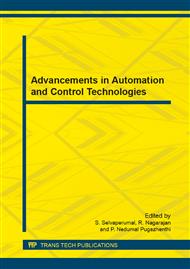[1]
V. Ionescu, I. Bostan, & L. Ionescu, Systematic Design for Integrated Digital Circuit Structures, IEEE Journal of Semiconductor Conference, 2004, Volume 2, p.467 – 470, (2004).
DOI: 10.1109/smicnd.2004.1403050
Google Scholar
[2]
Kogge P & Stone H, A Parallel Algorithm For The Efficient Solution Of A Several Class Of Recurrence Solution, IEEE trans compu, C-22 (1973)786-793.
DOI: 10.1109/tc.1973.5009159
Google Scholar
[3]
Giorgos Dimitrakopoulos and Dimitric Nikolos, High Speed Parallel –Prefix VLSI Ling Adders, IEEE Trans on computers, Vol. 54, No. 2, Feb (2005).
DOI: 10.1109/tc.2005.26
Google Scholar
[4]
P. M. Kogge and H. S. Stone, A Parallel Algorithm For The Efficient Solution Of A General Class Of Recurrence Equations, Computers, IEEE Transactions on, vol. C-22, no. 8, pp.786-793, Aug. (1973).
DOI: 10.1109/tc.1973.5009159
Google Scholar
[5]
P.G. Clem J. Sklansky, Conditional-sum addition logic, Electronic Computers, IRE Transactions on, vol. EC-9, no. 2, pp.226-231, June (1960).
DOI: 10.1109/tec.1960.5219822
Google Scholar
[6]
Information. R. Brent and H. Kung, A regular layout for parallel adders, Computers, IEEE Transac-tions on, vol. C-31, no. 3, pp.260-264, March (1982).
DOI: 10.1109/tc.1982.1675982
Google Scholar
[7]
B. Nireesha, E. Mahender Reddy & S. Latha, Simulation of Tree Adder Designed With Complementary Path Adiabatic Logic, IOSR Journal of VLSI and Signal Processing (IOSR-JVSP) Volume 3, Issue 4 (Nov. – Dec. 2013), PP 27-33.
DOI: 10.9790/4200-0342733
Google Scholar
[8]
SkalanskyJ, Conditional-Sum addition logic , IRE trans Electron compu, EC-9(1960)226-231.
Google Scholar
[9]
FPGAs David H. K. Hoe, Chris Martinez and Sri Jyothsna Vundavalli, Design and Characterization of Parallel Prefix Adders, IEEE 43rd Southeastern Symposium on system theory, March (2011).
DOI: 10.1109/ssst.2011.5753800
Google Scholar
[10]
Anitha R& V Bagyaveereswaran , High Performance Parallel Prefix Adders With Fast Carry Chain Logic, International Journal Of Advanced Research In Engineering and Technology (Ijaret) volume 3, issue 2, july-december (2012), pp.01-10.
Google Scholar
[11]
V. Ionescu, I. Bostan, & L. Ionescu, Systematic Design for Integrated Digital Circuit Structures, IEEE Journal of Semiconductor Conference, 2004, Volume 2, p.467 – 470, (2004).
DOI: 10.1109/smicnd.2004.1403050
Google Scholar
[12]
R. P Brent & H. T. Kung, A Regular Layout for Parallel Adders, IEEE Trans. Computers, Vol C-31, pp.260-264, (1982).
DOI: 10.1109/tc.1982.1675982
Google Scholar
[13]
M. M. Ziegler & M. R. Stan, A Unified Design Space for Regular Parallel Prefix Adders, IEEE Journal of Design, Automation and Test in Europe Conference and Exhibition, Volume 2, pp.1386-1387, (2004).
DOI: 10.1109/date.2004.1269100
Google Scholar
[14]
Dan Wang, Maofeng Yang, Wu Cheng, Xuguang Guan, Zhangming Zhu, Yintang Yang, 'Novel Low Power Full Adder Cells in 180nm CMOS Technology, IEEE ICIEA (2009).
DOI: 10.1109/iciea.2009.5138242
Google Scholar


